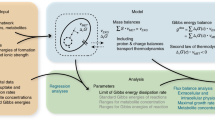Abstract
Yeast metabolism under hyperosmotic stress conditions was quantified using elementary mode analysis to obtain insights into the metabolic status of the cell. The fluxes of elementary modes were determined as solutions to a linear program that used the stoichiometry of the elementary modes as constraints. The analysis demonstrated that distinctly different sets of elementary modes operate under normal and hyperosmotic conditions. During the adaptation phase, elementary modes that only produce glycerol are active, while elementary modes that yield biomass, ethanol, and glycerol become active after the adaptive phase. The flux distribution in the metabolic network, calculated using the fluxes in the elementary modes, was employed to obtain the flux ratio at key nodes. At the glucose 6-phosphate (G6P) node, 25% of the carbon influx was diverted towards the pentose phosphate pathway under normal growth conditions, while only 0.3% of the carbon flux was diverted towards the pentose phosphate pathway during growth at 1 M NaCl, indicating that cell growth is arrested under hyperosmotic conditions. Further, objective functions were used in the linear program to obtain optimal solution spaces corresponding to the different accumulation rates. The analysis demonstrated that while biomass formation was optimal under normal growth conditions, glycerol synthesis was closer to optimal during adaptation to osmotic shock.










Similar content being viewed by others
References
Albertyn J, Hohmann S, Prior BA (1994) Characterization of the osmotic-stress response in Saccharomyces cerevisiae: osmotic stress and glucose repression regulate glycerol-3-phosphate dehydrogenase independently. Curr Genet 25(1):12–18
Blomberg A (1995) Global changes in protein synthesis during adaptation of the yeast Saccharomyces cerevisiae to 0.7 M NaCl. J Bacteriol 177(12):3563–3572
Blomberg A, Adler L (1989) Roles of glycerol and glycerol-3-phosphate dehydrogenase (NAD+) in acquired osmotolerance of Saccharomyces cerevisiae. J Bacteriol 171(2):1087–1092
Brewster J, de Valoir T, Dwyer N, Winter E, Gustin M (1993) An osmosensing signal transduction pathway in yeast. Science 259(5102):1760–1763
Çakir T, Kirdar B, Ülgen KÖ (2004) Metabolic pathway analysis of yeast strengthens the bridge between transcriptomics and metabolic networks. Biotechnol Bioeng 86(3):251–260
Carlson R, Fell D, Srienc F (2002) Metabolic pathway analysis of a recombinant yeast for rational strain development. Biotechnol Bioeng 79(2):121–134
Carlson R, Srienc F (2004) Fundamental Escherichia coli biochemical pathways for biomass and energy production: identification of reactions. Biotechnol Bioeng 85(1):1–19
Gayen K, Gupta M, Venkatesh KV (2007) Elementary mode analysis to study the preculturing effect on the metabolic state of Lactobacillus rhamnosus during growth on mixed substrates. In Silico Biol 7(2):123–139
Gayen K, Venkatesh KV (2006) Analysis of optimal phenotypic space using elementary modes as applied to Corynebacterium glutamicum. BMC Bioinform 7:445
Gianchandani EP, Papin JA, Price ND, Joyce AR, Palsson BO (2006) Matrix formalism to describe functional states of transcriptional regulatory systems. PLoS Comput Biol 2(8):902–917
Gustin MC, Albertyn J, Alexander M, Davenport K (1998) Map kinase pathways in the yeast Saccharomyces cerevisiae. Microbiol Mol Biol Rev 62(4):1264–1300
Hohmann S (2002) Osmotic stress signaling and osmoadaptation in yeasts. Microbiol Mol Biol Rev 66(2):300–372
Klamt S (2006) Generalized concept of minimal cut sets in biochemical networks. Biosystems 83(2–3):233–247
Klamt S, Gilles ED (2004) Minimal cut sets in biochemical reaction networks. Bioinformatics 20(2):226–234
Klamt S, Saez-Rodriguez J, Lindquist JA, Simeoni L, Gilles ED (2006) A methodology for the structural and functional analysis of signaling and regulatory networks. BMC Bioinform 7:1–26
Klipp E, Nordlander B, Kruger R, Gennemark P, Hohmann S (2005) Integrative model of the response of yeast to osmotic shock. Nat Biotechnol 23(8):975–982
Lambert M, Neish AC (1950) Rapid method for estimation of glycerol in fermentation solution. Can J Res 28:83–89
Loray MA, De Figueroa LIC, Hofer M (1998) Effect of salt stress on sugar uptake in osmotolerant yeasts. Folia Microbiol (Praha) 43(2):204–206
Papin JA, Price ND, Wiback SJ, Fell DA, Palsson BO (2003) Metabolic pathways in the post-genome era. Trends Biochem Sci 28(5):250–258
Poolman MG (2006) ScrumPy: metabolic modelling with Python. Syst Biol 153(5):375–378
Poolman MG, Fell DA, Raines CA (2003) Elementary modes analysis of photosynthate metabolism in the chloroplast stroma. Eur J Biochem 270(3):430–439
Reed RH, Chudek JA, Foster R, Gadd GM (1987) Osmotic significance of glycerol accumulation in exponentially growing yeasts. Appl Environ Microbiol 53(9):2119–2123
Schilling CH, Letscher D, Palsson BO (2000) Theory for the systemic definition of metabolic pathways and their use in interpreting metabolic function from a pathway-oriented perspective. J Theor Biol 203(3):229–248
Schuster S, Dandekar T, Fell DA (1999) Detection of elementary flux modes in biochemical networks: a promising tool for pathway analysis and metabolic engineering. Trends Biotechnol 17(2):53–60
Schuster S, Fell DA, Dandekar T (2000) A general definition of metabolic pathways useful for systematic organization and analysis of complex metabolic networks. Nat Biotechnol 18(3):326–332
Schuster S, Hilgetag C (1994) On elementary flux modes in biochemical reaction systems at steady state. J Biol Syst 2:165–182
Singh KK, Norton RS (1991) Metabolic changes induced during adaptation of Saccharomyces cerevisiae to a water stress. Arch Microbiol 156(1):38–42
Trinh CT, Carlson R, Wlaschin A, Srienc F (2006) Design, construction and performance of the most efficient biomass producing E. coli bacterium. Metab Eng 8(6):628–638
van Gulik WM, Heijnen JJ (1995) A metabolic network stoichiometry analysis of microbial growth and product formation. Biotechnol Bioeng 48(6):681–698
Vanrolleghem PA, de Jong-Gubbels P, van Gulik WM, Pronk JT, van Dijken JP, Heijnen S (1996) Validation of a metabolic network for Saccharomyces cerevisiae using mixed substrate studies. Biotechnol Prog 12(4):434–448
Wlaschin AP, Trinh CT, Carlson R, Srienc F (2006) The fractional contributions of elementary modes to the metabolism of Escherichia coli and their estimation from reaction entropies. Metabol Eng 8(4):338–352
Author information
Authors and Affiliations
Corresponding author
Electronic supplementary material
Below is the link to the electronic supplementary material.
Rights and permissions
About this article
Cite this article
Parmar, J.H., Bhartiya, S. & Venkatesh, K.V. Quantification of metabolism in Saccharomyces cerevisiae under hyperosmotic conditions using elementary mode analysis. J Ind Microbiol Biotechnol 39, 927–941 (2012). https://doi.org/10.1007/s10295-012-1090-4
Received:
Accepted:
Published:
Issue Date:
DOI: https://doi.org/10.1007/s10295-012-1090-4




